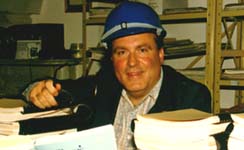 Ernst
Zündel Replies:
Ernst
Zündel Replies:Rebuttal # 5
 Ernst
Zündel Replies:
Ernst
Zündel Replies:It is true that the award plus court costs were paid. Mermelstein "won" the court case because the judge took "judicial notice" of the Holocaust.
Judicial notice means the following:
"There are certain facts that cannot be argued. It cannot be argued that the sun sinks in the West, or that Washington, D.C. is the capital of the United States of America. These things are facts.
The Holocaust is such a fact. There is the door. The argument is over. Case closed."
Was anything proven or disproven that way? Of course not. There was
no opportunity. The deck was stacked. It is impossible to win a case against
a judge who makes that kind of a priori ruling.
Imagine a judge who will say to such an insurance company that fights a
claim that is not substantiated by forensic evidence: "The accident
happened. That is a fact. The claims are legitimate. There is nothing to
argue about. Get out of my sight."
Is that considered impartial, unbiased, civilized legal justice in any
court of law?
Unfortunately, when it comes to Revisionism, many judges have taken that
approach. While fighting back, stating their case and defending their viewpoint,
Revisionists have had to contend themselves by arguing as follows, to use
the previous analogy about an "accident" where an insurance company
is zapped with having to pay restitution whereas the plaintiff has nothing
to "prove":
"Granted that there was an accident. But what kind of an accident? Was it a car? What color? What make? What capacity?
Was it even a car? Was it a train? Was it a plane?
Why do the witnesses tell stories that simply don't check out against the simplest scientific criteria?"
In other words, in the past Revisionists have argued detail against
a foregone judicial conclusion. Nizkor admits as much by stating glibly:
". . . the American court system is not meant to be a place for people
to try to prove crackpot theories."
But that is the crux of the matter that has escaped Nizkor so far. How
can you defend yourself against a judge who acts like an ostrich when it
comes to Holocaust claims and details?
It is impossible.
It is instructive, though, to know how some of the details surrounding
Mermelstein played out. The Institute for Historical Review went
to some length to check out the Mermelstein claim that he and his relatives
had indeed been the victims of genocide or attempted genocide.
The entire unsavory matter has been summarized by Theodore J. O'Keefe in
'Best Witness': Mel Mermelstein, Auschwitz and the IHR. I am quoting
here excerpts of some of the details that were unearthed in what turned
out to be one of the sadder chapters of American jurisprudence:
". . . with the help of high-priced lawyers, a corrupt media, and Jewish terrorists, Mermelstein seemingly laid to rest the historical issue by obtaining Judge Johnson's ridiculous judicial notice. His lawyers went on to concoct a massive $17 million assault for breach of contract, conspiracy, intentional infliction of emotional distress, and so forth, until IHR had virtually no choice but to capitulate by settling out of court in preference to losing a potentially ruinous trial.
The frustrating thing for all informed and conscientious Revisionists was that the IHR's researchers were aware from the beginning, thanks to the very affidavit Mermelstein presented to claim the $50,000 reward, that when he described watching his mother and sisters enter "gas chamber no. 5" through a tunnel, he was speaking of an impossibility, an absurdity that became even more absurd six months later, when, in sworn testimony, he said he'd seen them going down the stairs into the tunnel to the gas chamber. Why? Because even then it was well known to all students of Auschwitz that "gas chamber no. 5" -- in fact, Auschwitz Krematorium building V -- had no stairs descending from the outside, no tunnel, and no basement. It was entirely above ground!
As the IHR's staff and supporters gathered more evidence, in the months and years of the first trial, they learned more. In Mermelstein's own book, By Bread Alone, which offers a detailed account of the single night and day he spent at Birkenau (May 21-22, 1944), and which was published only two years before his sworn affidavit in application for the reward, Mermelstein wrote nothing of witnessing his mother and sisters enter any building at all, let alone any gas chamber -- whether down the stairs, up the ladder, through the window, or down the chimney.
During the course of the long discovery phase, that is, the period in which the opposing parties gather evidence to support their case, researchers for the IHR, led by Louis A. Rollins, were able to gather much more information about what Mermelstein had said (or hadn't said), and was still saying, about his experiences in wartime Europe.
Working from a mass of statements, either direct or reported, made by Mermelstein about his past life (paying particular attention to his time at Auschwitz and other camps), Rollins was able to compile a list of instances in which, it seemed to him, Mermelstein had either:
- First, contradicted himself in his various statements on what he had seen or experienced during the Holocaust (for example, his several different accounts of how and where his father died), or;
- Second, made absurd claims about what had happened to him and others during the Holocaust -- for example, witnessing a non-existent tunnel leading to the imaginary cellar of Krematorium 5, or being ordered to wash with soap made from dead Jews.
Contradictions and absurdities -- Lou Rollins compiled 33 of them on a list that ran to eleven pages. But because of the judicial notice, all of this research went to naught."
And later, as the Mermelstein claim resulted in a second "judicial notice" and a lot of grief for the Institute for Historical Review that was pinned against a set of loaded dice:
"Aided by numerous volunteers who worked not only in California but across the United States, and in Germany, Poland, and Israel, we searched for whatever we could find about Mermelstein and his family. This included evidence about his mental soundness (Mermelstein had admitted to being under the care of a psychiatrist); information as to his litigation with persons other than the IHR; newspaper reports quoting Mermelstein on his Auschwitz experiences; and, of course, wartime documents from Auschwitz and elsewhere that would disprove his claims about witnessing atrocities, above all the alleged gassing of his mother and sisters at Auschwitz in May 1944.
A first step was to nail down the existing evidence, much of it from the first trial: Mermelstein's sworn statements in the form of transcribed depositions (of which there were eleven, running to some twelve hundred pages of close interrogation by IHR and Liberty Lobby lawyers), written responses to interrogatories, and the like; Mermelstein's writings, above all his autobiographical account of his concentration camp experiences, By Bread Alone; and his public statements on his Holocaust years, reported in more than a hundred different newspaper and magazine articles, and on several recordings of presentations by Mermelstein at synagogues or seminars as well as on radio broadcasts.
Further evidence came from history and reference books, such as Jewish encyclopedias; public documents and records, including statements made by Mermelstein to authorities at the Auschwitz State Museum and the German consulate in Los Angeles; wartime documents from the German camps; and Mermelstein's US Army medical records.
As this mass of paper and audiotape accumulated, (we) had to read and re-read, to analyze and evaluate, to extract and collate and tabulate the evidence that would serve our defense against Mermelstein's complaint . . . While Mermelstein was a rather difficult witness who had attempted (sometimes with success) to intimidate IHR attorneys during depositions by playing the Holocaust card, he was often boastful and extravagant, and provided many nuggets for analysis and comparison. . .
(We) compiled a new list, longer and more thorough than his original . . . This listing had to be not only exhaustive, but reasonable and persuasive. Citing mere slips of the tongue, or mistakes attributable to sloppy journalists, would not only have been poor scholarship, it wouldn't have persuaded a jury.
In all, (we) discovered 30 absurdities, 22 contradictions, and a number of exaggerations. These examples went directly to the matter of Mermelstein as a "demonstrable fraud," a "vainglorious prevaricator," and a "false-tale spinner."
Among the absurdities were the nonexistent subterranean tunnel to the above-ground crematory, the soap made from Jewish bodies, a claim that Auschwitz camp "were rewarded for every prisoner they killed," and that there was a railroad track leading from the crematory to a pond for dumping ashes.
Since the summer of 1980, Mermelstein has repeatedly stated that he saw his mother and sisters go into a gas chamber, or into tunnel leading to it, from a distance of "a stone's throw away," a distance of "40, 50 feet," and that he watched the "gas chamber" building for "a couple of hours." Remarkably, though, Mermelstein made no mention of witnessing any of this in any account available prior to 1980, including his supposedly autobiographical book, By Bread Alone.
This is nothing compared to his varying versions of the fate that befell his father. In a declaration given in November 1969 at the German consulate in Los Angeles, Mermelstein said his father died during "evacuation marches to Blechhammer from other camps." According to the account given in By Bread Alone, though, Mermelstein's father died in bed after working himself to death, trading food for cigarettes. In a May 1981 deposition, his father had died of overwork and exhaustion, while in a June 1985 deposition, he died of "exhaustion, cruelty, starvation, and beatings." According to still other accounts given by Mel Mermelstein, his father was "gassed at Auschwitz."
Mermelstein has given similarly contradictory accounts of what he did while interned at Auschwitz (between approximately May 21 and July 1, 1944). In a statement given in November 1969 at the German consulate in Los Angeles, he had "no occupation." Similarly, in a May 1981 deposition, he declared that he had done "practically nothing ... just some detail work" and "no physical work."
In February 1987, a dramatically different account of Mermelstein's time in Auschwitz appeared. Ed Koch (who was then mayor of New York City) told of a meeting with Mermelstein during a tour of Auschwitz. Koch reported in a newspaper article that Mermelstein had told him: "I was part of the special detail which hauled the bodies from the gas chamber and took them to the crematoria."
In claiming that Auschwitz camp kapos would kill an inmate if "they didn't like the shape of your nose," Mermelstein seemed to suggest that his own nose was not unattractive. Survival could be just as cruel as death, Mel implied on another occasion, because the bread given to Auschwitz inmates (during the period when he claimed to have done "practically nothing") was intended not for nourishment, but to kill inmates "as fast as they expected us to die." At Buchenwald, Mermelstein would have us believe, he went swimming "in blood," even though he and others had been transported to Buchenwald "only for one purpose" -- to be disposed of in a crematorium rather than "litter ... the beautiful towns and cities with our bodies."
Fortunately, Mermelstein and many others like him miraculously survived. One of these friends, Dr. Miklos Nyiszli (who wrote his own book about his stay entitled, Auschwitz: A Doctor's Eyewitness Account), was a truly exceptional survivor. In a 1981 deposition, Mermelstein claimed that Dr. Nyiszli, whom he supposedly knew personally, would testify on Mermelstein's behalf about the alleged crimes of Dr. Josef Mengele at Auschwitz. At that time, though, Nyiszli had been dead for more than 25 years. . .
In addition to all the evidence cited above, we obtained yet another piece of potentially explosive evidence: a document that indicates that Mermelstein's sisters may have been alive nearly five months after he insisted they were killed. This secret German document, dated October 12, 1944, lists 500 Jewish females who were being transported from Auschwitz to Altenburg (a sub-camp of Buchenwald). Among those listed are Edith and Magda Mermelstein, names identical to those of Mermelstein's two sisters. This document is dated almost five months after the day in May 1944 when Mermelstein swears he saw them gassed. While the birth dates of Edith and Magda as typed on this document do not tally precisely with those given by Mermelstein for his two sisters in By Bread Alone, there is good reason to believe that the two women on the list were, in fact, his sisters.
From the volume of evidence we acquired, we learned two important things:
- First, that Mermelstein is simply not a credible witness to gassings at Auschwitz, or to very much else involving concentration camps and the Holocaust. The contradictions, exaggerations, and absurdities lovingly noted and recorded by the IHR's researchers amply demonstrate this, not merely to Revisionists and others skeptical of "survivor" testimony, but any knowledgeable, intelligent, and fair-minded person. Whether Mermelstein is fibbing, to others or to himself; whether he has forgotten; or whether whatever he did experience has so deranged his mind as to render him incapable of rationally recounting the facts, his testimony proves nothing about the existence of Nazi gas chambers or a policy to exterminate Jews. If anything, careful analysis of his statements indicates the opposite: that there were no Auschwitz gas chambers or German policy to exterminate the Jews.
- Second, there is no evidence that Mermelstein ever claimed to have witnessed the gassing of his mother and sisters until after he learned of the IHR's reward offer. He apparently first claimed to have personally seen them enter a so-called gas chamber in letters attacking the IHR that appeared in newspapers in southern California and Israel in the summer of 1980.
Neither his book, By Bread Alone (published in 1979), nor a statement made for the Auschwitz State Museum in 1967 about his wartime experiences in the camp, nor a sworn affidavit given at the German consulate in Los Angeles in 1969 about crimes he had witnessed during his time at Auschwitz, contains a word about witnessing any gassing."
So much for the IHR/Mermelstein saga. But the IHR reward was not the
only one that has been offered. We know of at least two additional awards.
One was a rather hilarious and telling incident that happened during a
Deborah Lipstadt lecture in Atlanta a few years ago, as recounted in a
tape made by British historian David Irving.
Deborah Lipstadt was shooting from the lip, insisting that she had blueprints
from the Moscow Archives of Auschwitz architectural drawings of the gas
chamber, clearly showing the holes in the roof for throwing the gas pellets
in etc.
Irving stood up, pulled out $1,000, waved it around and said: "I will
give you this for a photocopy of these drawings."
Of course Lipstadt had no such drawings, and Irving is still waiting.
The third award was put up by a Brazilian citizen and well-known Revisionist
publisher, S. Castan, and it is in the amount of 6 million cruzeiros.
There is a taped interview explaining the criteria, available from the
Zündel-Haus, describing a highly exacting and impartial panel of judges
who will examine the evidence and decide who will get the award. I suggest
that the Nizkor people get busy.
Regarding the Michael Shermer challenge - who is Michael Shermer, except
the editor of Skeptic? He tried to debate Mark Weber at the Institute
for Historical Review, and that tape, too, is educational. It is worth
viewing and digesting. Those who were there have not forgotten that exchange.
It was like a bikini - what it revealed was interesting, but what it concealed
was telling.
Shermer, according to Nizkor's reply, has in an Open Letter ". . .
offered to take the IHR up on a similar offer, but only if they precisely
define ahead of time what they will accept as evidence." The claim
is that the IHR has not replied.
I cannot second-guess the IHR and what their motives are, but I can tell
you what I will accept as evidence: forensic, scientific data in place
of musings, fairytales or what has been described by one Jewish historian
as
". . . preposterous verbosity, graphomanic exaggeration, dramatic effects, overstated self-inflation, dilettante philosophizing, would-be lyricism, unchecked rumors, bias, partisan attacks, and apologies."
In Auschwitz, the Zionists and Communists claimed for 50 years that "four million died" - they were lying.
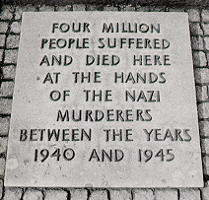 ..
..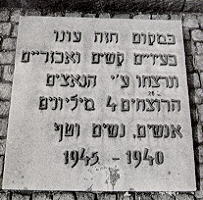
Under duress, after the Zundel trial they reduced that number to 1.6 million, and they were still lying.
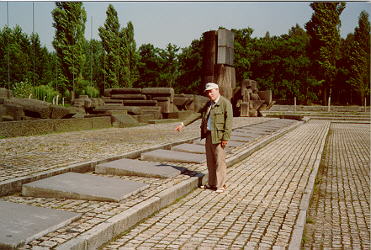
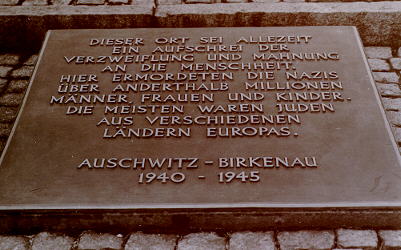
Pressac decided it was 800,000, and he, too, was lying.
The count now stands at 74,000 dead - registered meticulously in the Auschwitz
Death Books released by Gorbachev to the International Red Cross, after
a worldwide write in campaign organized by Ernst Zundel after his 1988
trial, to Michael Gorbachev to release those then missing volumes of the
Auschwitz Death Records.
And is it over yet?
Revisionism is an evolutionary science. Truth must and will be revealed
- one scientific document at a time.
April 22, 1996